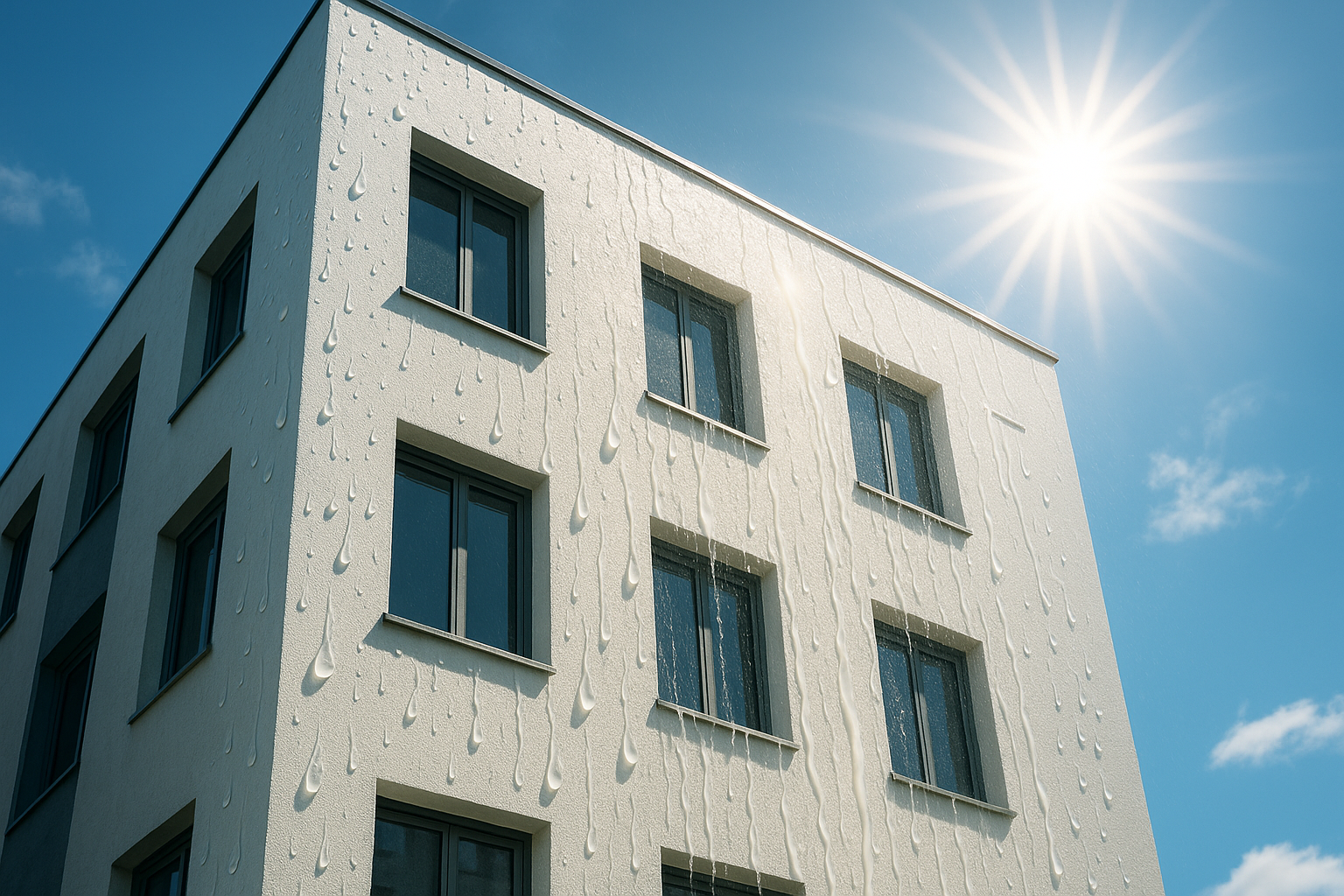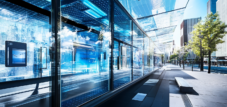
Innovative facade paint | Revolutionary cooling paint: When buildings sweat to save energy – Image: Xpert.Digital
Singaporean researchers develop cooling wall paint to combat urban heat island effect
Innovative facade technology combines three cooling mechanisms in one material
A breakthrough in building cooling could fundamentally change how we deal with urban heat. Researchers at Nanyang Technological University in Singapore have developed an innovative facade paint that not only cools individual buildings but also has a positive impact on the entire urban environment. This groundbreaking technology combines three physical cooling mechanisms in a single material, achieving energy savings of up to 40 percent.
Suitable for:
- Urban planning: The Green-PV roof concept (photovoltaics & green roof) alongside facade solar & the Solar City Pergola for a better urban climate
The science behind “sweating” paint
Composition and structure
The revolutionary paint is based on a cement-like coating made from calcium silicate hydrate, one of the main components of concrete, which is mixed with water and supplemented with nanoparticles. This formulation, called CCP-30, consists of a porous network of calcium silicate hydrate gel modified by nanoparticles. The porous structure allows the paint to retain approximately 30 percent of its weight in water.
Triple cooling mechanism
The innovative material uses three different cooling principles:
1. Highly efficient reflection
The paint reflects 88 to 92 percent of incident sunlight, even when wet. Unlike conventional white paints, it does not reflect light across a broad spectrum of infrared radiation, but primarily within a wavelength range of 8 to 13 micrometers.
2. Passive radiative cooling
The paint emits up to 95 percent of the absorbed heat as infrared radiation. These wavelengths are within the atmospheric window and are reflected back into space almost undisturbed, resulting in less heat buildup in the surrounding area compared to a conventionally white-painted building.
3. Evaporative cooling
The crucial breakthrough lies in the third mechanism: The nanoparticles absorb water from rain and humidity and release it slowly, similar to how human skin sweats. When the stored water evaporates, it draws a large amount of heat from the surroundings.
Exceptional performance data
Cooling performance in tropical climates
In field tests in Singapore, one of the world's wettest cities, the new paint demonstrated impressive results. The CCP-30 paint delivered up to ten times the cooling performance of commercial cooling paints in tropical climates. This is particularly significant because conventional radiative cooling paints perform poorly in humid environments, as water vapor in the air traps heat near the surface.
Long-term tests confirm durability
After two years of tropical sun and rain in Singapore, the innovative paint remained perfectly white, while conventional white and commercial cooling paints yellowed. This durability is crucial for maintaining high reflectivity and cooling performance over time.
Energy savings and environmental impact
Significant reduction in energy consumption
Pilot studies in buildings showed energy savings of 30 to 40 percent compared to conventional cooling methods. A life cycle analysis revealed a 28 percent lower CO₂ footprint per functional unit compared to standard paint. These savings are enormously important, as building cooling accounts for approximately 20 percent of total electricity consumption worldwide and makes a significant contribution to CO₂ emissions.
Combating the urban heat island effect
Real-world tests conducted by NTU Singapore have demonstrated that cooling paints can make pedestrians feel up to 1.5 degrees Celsius cooler. The coated areas were up to 2 degrees Celsius cooler than uncoated areas during the hottest part of the day. Approximately 30 percent less heat was emitted from the painted buildings and pavements.
Suitable for:
- Urban planning retrofit - the city of the future from gray to green - solar parking spaces and solar pergolas as a weapon against sealed areas and heat islands
Practical application and future prospects
Optimal operating conditions
The developed paint unfolds its greatest potential benefit in humid, sunny, and densely populated environments. Singapore, along with many other large cities in tropical latitudes, would be a perfect location to significantly reduce energy consumption for air conditioning in the future.
Pilot projects already underway
The technology is already being tested in practice. Singapore's industrial development corporation JTC plans to use the reflective paint coating on buildings in Bukit Batok and Sin Ming. Furthermore, NTU also tested the use of cooling paint on two Housing Board blocks in Bukit Purmei in 2020, before HDB expanded its use to 130 blocks in Tampines.
Self-sustaining properties
What makes CCP-30 paint particularly special is its self-refreshing ability – it can absorb water from rain and atmospheric humidity to maintain evaporative cooling over time without affecting the paint's light interaction when wet.
Scientific breakthrough: Passive cooling technology lowers temperatures without any energy input
This innovative cooling paint represents a significant advancement in passive cooling technology, consuming no energy yet delivering substantial cooling performance. With its ability to conserve energy, reduce emissions, and cool cities naturally, CCP-30 could play a key role in the fight against climate change – one coat at a time.
The research findings, published in the prestigious journal Science, mark a turning point in the development of sustainable building cooling. This technology offers a practical and long-term solution for mitigating the urban heat island effect and could be particularly beneficial in developing countries where electricity infrastructure may be inadequate or air conditioning unaffordable.
Suitable for:
Your global marketing and business development partner
☑️ Our business language is English or German
☑️ NEW: Correspondence in your national language!
I would be happy to serve you and my team as a personal advisor.
You can contact me by filling out the contact form or simply call me on +49 89 89 674 804 (Munich) . My email address is: wolfenstein ∂ xpert.digital
I'm looking forward to our joint project.

